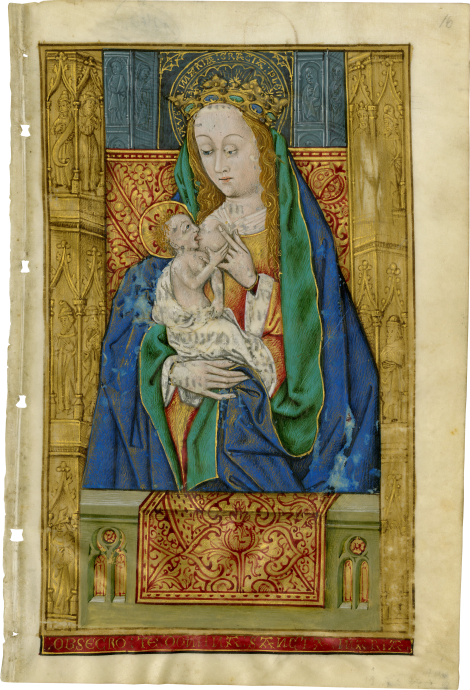The Nursing Madonna Master of the Apocalypse of Aymar de Poitiers



Master of the Apocalypse of Aymar de Poitiers (active Dauphiné, c. 1480-1490)
, c. 1480-1490Master of the Apocalypse of Aymar de Poitiers (active Dauphiné, c. 1480-1490)
Description
This captivating full-page miniature from a French Book of Hours shows the Nursing Madonna, or Madonna lactans, with a jewel-studded crown and flowing mantle. Cradling the tiny infant Christ at her breast, Mary is shown in three-quarter length behind a draped balustrade and framed by illusionistic piers with figural niches, her halo inscribed “Ave Maria gracia plen[a].” The opening of the Obsecro te prayer is written in gold on red at the lower edge. The miniature is very likely adapted from a print of the same subject, perhaps by the Master W with the Key (figure 1) or Israhel van Meckenem (figure 2). Other miniatures from the same dismembered Book of Hours directly imitate prints by these artists, as in a full-page miniature with Betrayal and Capture of Christ, originally f. 21 (figures 3 and 4).
The leaf comes from a Book of Hours, Use of Rome, where it was folio 16. Partly dismembered in 1922 or 1923, the largest fragment of 75 folios along with its seventeenth-century binding, probably made in Geneva, survives at the Lilly Library in Bloomington, Indiana, as Ricketts 136 (see De Hamel 2010, pp. 184-5). A full-page miniature with King David shows a similar technique with graphic folds of drapery delineated in colorful hatchings and enlivened with gold. Small details are paralleled in the present miniature, like the gold-set gems that appear in the Virgin Mary’s crown that also decorate David’s robes (figure 5). Before it was broken the parent Book of Hours belonged to notable English bibliophiles, including Charles Dyson Perrins. The present miniature was described in its original manuscript context in the 1921 Baer catalogue (as “Bl. 16, Maria, das Christkind säugend, in reicher gotischer Umrahmung mit Bildwerken”). Its condition, including losses of lead white, appear to be unchanged since the leaf was illustrated in the 1933 Helbing catalogue (figure 6), there identified as Eastern French, c. 1470.
The artist was named the Maître de l’Apocalypse d’Aymar de Poitiers by François Avril for an illuminated Apocalypse in Glasgow with the arms of Aymar of Poitiers (University Library, Hunter 398). Also attributed to this artist are six full-page miniatures from a Book of Hours at the Louvre (Cabinet des dessins, inv. no. MI 1083.A-E; Avril 2011, no. 112). The eccentric full-page miniatures with theatrical settings are delightful adaptations from popular engravings coming from the Southern Netherlands and Germany, especially those by Israhel van Meckenem. As noted by Avril (2011, p. 216), our artist also illuminated a Book of Hours now in a private collection, displaying a similar use of bold color and vigorous hatchings (figure 7, formerly Les Enluminures BOH 36).
The lower edge is written in gold on red opening the prayer “OBSECRO TE DOMINA SANCTA MARIA,” like the other full-page miniatures from the parent Book of Hours (figure 5). The folio number “16” is written in pencil in the top corner, with erased pencil inscriptions at the lower edge. The verso written on 20 lines in a single column ruled in light red (written space 134 x 81 mm.) in a bâtarde script with two long flourishes into the margins, continuing the Obsecro te begun on the recto and ending “...humilitatem per quas filius tuus dominus [...].” The miniature rubbed in places, especially the right architectural frame, with uniform losses of lead white, significant in areas and revealing the preparatory drawing (consistent with the state of the leaf when illustrated in 1933), with a scratch across the Virgin’s mantle. The parchment leaf with four holes for original binding and two smaller holes perhaps for tackets, with remnants of paper from former mount at edges of the verso.
Parent manuscript and sister leaves:
The parent Book of Hours, Use of Rome, originally contained 21 full-page miniatures; the largest fragment of 75 folios with the seventeenth-century binding retains the calendar, 5 full-page, and many smaller miniatures, today in Bloomington, Indiana, Lilly Library Ricketts 136. For a full list of the 21 miniatures and notes on provenance, see de Hamel 2010, p. 184.
Provenance:
1. The parent Book of Hours belonged to the lawyer Thouvin, sieur du Bouillon, of Lassay, Maine (central France), 1717 (inscription on flyleaf of Ricketts 136, signed “Thibault”), and by descent to Madame Villatte à Lassay;
2. Rev. Walter Sneyd (his sale Sotheby’s, London, 16 December 1903, lot 383);
3. Charles William Dyson Perrins (his bookplate pasted inside Ricketts 136, the manuscript sold before the publication of the Dyson Perrins catalogue);
4. Rudolf Bush of Mainz (his sale, Baer, Frankfurt, 4 April 1921, lot 273; sold again among “other properties” at Sotheby’s, 7 February 1923, lot 568, to Quaritch);
5. The single leaf from a Southern German collection sold Frankfurt, Germany, Hugo Helbing, Catalogue 39, no. 457, ill. plate 25, 5 December 1933 (for 360 Reichsmark);
6. Heidelberg, Winterberg Kunst Auktionen und Galerie, 25 April 2015, lot 92.
Literature:
Joseph Baer & Co., Sammlung Rudolf Busch, Mainz: Versteigerung: Dienstag, den 3. Mai 1921, vol. 2, Illuminierte Manuscripte, Buchminiaturen, Incunabeln, Einbände, illustrierte Bücher: Versteigerung: Mittwoch, den 4. Mai 1921, Frankfurt, 1921, no. 273.
Hugo Helbing, Nachlass Geheimrat Franz Rieffel, Frankfurt A.M, Nachlass Eines Süddeutschen Sammlers...: Versteigerung: Dienstag, 5. December 1933 [Catalogue 39], Frankfurt, 1933, no. 457, ill. plate 25.
C. de Hamel, Gilding the Lilly: A Hundred Medieval and Illuminated Manuscripts in the Lilly Library, Bloomington, 2010, no. 84, pp. 184-185.
F. Avril, in Les enluminures du Louvre, moyen âge et Renaissance, ed. F. Avril, N. Reynaud, and D. Cordellier, Paris, 2011, p. 212.